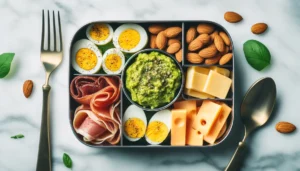Understanding Carbohydrates on the Keto Diet
Carbohydrates, commonly known as carbs, are one of the main types of nutrients in our diet and the primary energy source for many people. In a typical diet, carbs are consumed in large amounts, providing the energy that your body needs for daily activities. However, the ketogenic diet flips this approach by drastically reducing carb intake and replacing it with fats.
On a keto diet, it’s not just about cutting back on any carbs; it’s about focusing on what we call “net carbs.” This term refers to the carbohydrates that impact your blood sugar levels, which are crucial for maintaining ketosis. To calculate net carbs, subtract the amount of fiber and certain sugar alcohols from the total carbs in a food item. This is because fiber and some sugar alcohols do not raise blood sugar like other carbs.
Here are the main points about carbohydrates in a keto diet:
- Types of Carbohydrates: On keto, you should avoid simple carbohydrates, which are found in sugary foods and drinks, as well as complex carbohydrates, which are present in bread, pasta, and certain vegetables.
- Net Carbs: Calculating net carbs is essential for staying within your daily carb limit and keeping your body in ketosis. You aim to consume foods low in net carbs, such as leafy greens and non-starchy vegetables.
- Carb Limits: Generally, staying under 50 grams of net carbs per day will help most people maintain ketosis. This limit ensures that your body switches from using carbohydrates to fat as its main energy source, promoting fat burning and weight loss.
By understanding and managing your carb intake, you set the stage for success on the ketogenic diet. Up next, we’ll explain into the daily carb limits specific to various types of ketogenic diets, providing you with a clearer picture of how to tailor the diet to your needs.
How Many Carbs A Day On Keto? – Carb Limits on Different Types of Keto Diets
The ketogenic diet comes in several variations, each designed for different lifestyles and health goals. Here, we will explore the carb limits associated with each type of keto diet. Understanding these variations will help you choose the best approach for your personal needs.
Standard Ketogenic Diet (SKD)
The Standard Ketogenic Diet is the most researched and recommended form of keto. It typically consists of:
- 70% Fat
- 20% Protein
- 10% Carbs
On the SKD, you should aim to consume up to 50 grams of net carbs per day. This strict carb limit helps maintain ketosis, where the body efficiently burns fat for energy.

Cyclical Ketogenic Diet (CKD)
The Cyclical Ketogenic Diet is designed for athletes and those who engage in high-intensity workouts. This diet involves:
- 5 Low-Carb Days: Followed by
- 2 High-Carb Days
During the high-carb days, carb intake increases significantly to replenish glycogen stores. This cycle supports recovery and performance in athletic activities.
Targeted Ketogenic Diet (TKD)
The Targeted Ketogenic Diet allows additional carbs around workout times. This approach is beneficial for those who need extra energy for intense physical activities. It typically involves:
- Adding 20-50 grams of carbs: 30 minutes to an hour before exercise
This method helps maintain energy levels during workouts without exiting ketosis for long periods.
High-Protein Ketogenic Diet (HPKD)
The High-Protein Ketogenic Diet is similar to the standard approach but with more protein, which is helpful for muscle repair and growth. The macronutrient distribution is:
- 60% Fat
- 35% Protein
- 5% Carbs
This variant allows up to 50 grams of carbs but increases protein intake, which is ideal for those looking to gain muscle while losing fat.

By choosing the keto diet that aligns with your physical activities and health objectives, you can optimize your eating plan for better results. In the next section, we will explain how to calculate net carbs, a crucial skill for managing your carb intake effectively on any ketogenic diet.
How to Calculate Net Carbs
Calculating net carbs is essential for anyone following a ketogenic diet, as it allows you to manage your carbohydrate intake precisely. This calculation helps ensure that you stay within your daily carb limit to maintain ketosis. Here’s how to do it effectively:
Total carbs include all the carbohydrate content of a food item. This number is your starting point. You can find it on food labels or in nutritional databases.
To find the net carbs in a food, subtract the grams of fiber and half the grams of sugar alcohols from the total carbs. Here’s why:
- Fiber: This is a type of carbohydrate that the body cannot digest, so it does not contribute to blood sugar levels. Including fiber in your total carb count could mislead you about the food’s ketogenic compatibility.
- Sugar Alcohols: These are often used as sugar substitutes in sugar-free and low-carb products. However, not all sugar alcohols affect blood sugar the same way. Some have a minimal impact, which is why only half of their content is subtracted.
Step-by-Step Calculation
Here is a simple example to illustrate the calculation of net carbs:
- Total Carbs: 30 grams
- Fiber: 9 grams
- Sugar Alcohols: 10 grams (half subtracted = 5 grams)
- Net Carbs: 30g – 9g – 5g = 16 grams
By following these steps, you can determine the net carb content of most foods, helping you make informed choices about what to eat.
Practical Application
It’s beneficial to practice this calculation with the foods you commonly eat. Consider keeping a list of the net carbs in different foods to make meal planning easier. Apps and digital tools can also help track your intake, ensuring you stay on target with your carb limits.
Calculating net carbs accurately will empower you to maintain ketosis and achieve your health and fitness goals on the ketogenic diet. In the next section, we’ll explore the foods that are most compatible with the keto diet, focusing on those low in net carbs and beneficial for maintaining your state of ketosis.
Foods to Eat, Foods to Avoid on Keto
When determining “how many carbs a day on keto,” it’s also vital to understand which foods align with these carb limits. Choosing the right foods is crucial for staying in ketosis and achieving the benefits of the ketogenic diet. This section outlines the foods you should focus on and those to avoid.
Foods to Include in Your Keto Diet
Low Net Carb Proteins:
- Fresh Meat and Fish: Foods like chicken, beef, pork, and fish are staples in the keto diet because they contain zero carbs and are rich in high-quality protein.
- Example: Salmon and beef are excellent for their omega-3 and iron content, respectively.
High-Fat Dairy Products:
- Cheese and Cream: These are good sources of fat and have very low net carb content, making them ideal for keto.
- Example: Cheddar cheese contains about 2.44g net carbs per 100 grams and is high in fat.
Healthy Fats:
- Oils and Butters: Coconut oil, olive oil, and butter are important for cooking and ensuring sufficient fat intake.
- Example: Coconut oil is beneficial for its medium-chain triglycerides (MCTs), which support ketosis.
Low-Carb Vegetables:
- Leafy Greens and Above-Ground Vegetables: Vegetables like spinach, kale, and broccoli are low in net carbs but high in fiber and nutrients.
- Example: Broccoli has about 4.04g net carbs per 100 grams and is packed with vitamin C and K.
Nuts and Seeds:
- Low-Carb Options: Almonds, walnuts, and flaxseeds are low in net carbs and provide healthy fats.
- Example: Flaxseeds are not only low in net carbs (1.58g per 100g) but also high in omega-3 fatty acids.

Foods to Avoid on Keto
High-Carb Fruits and Vegetables:
- Starchy Vegetables and Sweet Fruits: Potatoes, bananas, and apples are high in carbs and can disrupt ketosis.
- Example: A medium-sized banana contains about 20.24g of net carbs.
Grains and Sugars:
- Bread, Pasta, Rice, and Sweets: These are typically high in carbohydrates and low in nutritional value for keto dieters.
- Example: A slice of white bread typically contains around 14g of net carbs.
Legumes and Some Dairy:
- Beans, Lentils, and Milk: These foods are generally high in carbs and can prevent maintaining ketosis.
- Example: A cup of cooked lentils has about 40g of net carbs.
Understanding “how many carbs a day on keto” involves more than just counting numbers; it requires making smart choices about the types of foods you eat. By focusing on foods low in net carbs and avoiding those high in digestible carbs, you can ensure that your keto diet is effective and sustainable. In the next section, we’ll provide practical tips for implementing these dietary choices smoothly into your lifestyle.
Practical Tips and Gradual Changes
Adopting a ketogenic diet involves more than just knowing “how many carbs a day on keto”; it requires thoughtful changes to your eating habits and lifestyle. This section offers practical tips to help you transition smoothly and sustainably into the keto diet.
Start Slowly
Gradually reducing your carb intake can make the transition to keto less daunting. For instance, you might begin by eliminating sugary beverages one week, then removing bread and pasta the following week. This phased approach helps your body adjust without overwhelming you.
Focus on Whole, Unprocessed Foods
Emphasizing whole foods not only supports your keto efforts but also enhances your overall health. For example, choose fresh meat over processed meats and opt for whole vegetables instead of canned ones. This ensures you get more nutrients and fewer additives, which can impact ketosis and overall health.
Plan Your Meals
Meal planning is crucial on the keto diet. Organizing what you will eat for the week helps you stay on track and avoid high-carb temptations. Additionally, having a plan reduces stress and last-minute decisions that could derail your diet goals.

Utilize Keto-Friendly Snacks
Snacking smartly is essential. Keep keto-friendly snacks handy, like nuts, cheese, or hard-boiled eggs, to combat hunger without exceeding carb limits. These snacks are not only satisfying but also help maintain stable energy levels throughout the day.
Stay Hydrated
Interestingly, increasing your water intake is vital when you start keto. Because a low-carb diet reduces insulin levels, your body sheds more sodium and water. Staying hydrated helps prevent dehydration and the feeling of fatigue, often experienced during the initial phase of ketosis.
Monitor Your Carb Intake
Finally, keep a close eye on your daily carb consumption. Tools like smartphone apps can track your meals and calculate net carbs automatically. Consistently monitoring helps you make necessary adjustments to stay within your carb limit, crucial for maintaining ketosis.
By following these tips, you can ease your way into the ketogenic diet and make it a sustainable part of your lifestyle. Moreover, these strategies ensure that you continue to enjoy your meals while adhering to the “how many carbs a day on keto” guideline effectively. In our final section, we will summarize the key points and reinforce the benefits of sticking to your keto plan.
References
- Long-term effects of a ketogenic diet in obese patients: Journal of Obesity
- Dietary carbohydrate restriction as the first approach in diabetes management: Critical review and evidence base. Nutrition
- The effect of a low-carbohydrate, ketogenic diet versus a low-glycemic index diet on glycemic control in type 2 diabetes mellitus: Nutrition & Metabolism
- Effects of Ketogenic Diets on Cardiovascular Risk Factors: Evidence from Animal and Human Studies. Nutrients
- Significant Impact of the Ketogenic Diet on Low-Density Lipoprotein Cholesterol Levels. PubMed
- A Ketogenic Diet Substantially Reshapes the Human Metabolome. Clinical Nutrition
- Ketogenic Diet in Cancer Management. PubMed
- Effects of a High-Protein Ketogenic Diet on Hunger, Appetite and Weight loss… American Journal of Clinical Nutrition
- The effects of the ketogenic diet for the management of type 2 diabetes mellitus: A systematic review and meta-analysis of recent studies. Diabetes and Metabolic Syndrome
- Ketogenic Keys to Body Composition: Nutritional Insights and Comparative Dietary Effects. (PDF) Journal of Biomedicine




